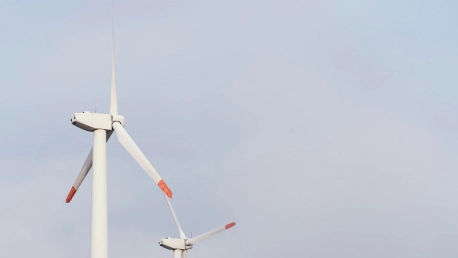In an era marked by urgent climate action, wind energy has emerged as a beacon of hope, recently achieving an unprecedented milestone of 1TW (terawatt) of global capacity. This leap forward comes on the heels of a record-breaking year that saw the installation of 117 gigawatts (GW) of new wind generation capacity—a 50% surge from the year before. But even as wind turbines carve the skies across continents, the wind industry faces a gale of challenges. With economic headwinds, infrastructural constraints, and policy gaps, the sector confronts the reality of scaling up to meet the ambitious climate targets set by the international community. As the wind of change gusts ever stronger, the industry must navigate the complex terrain of rapid growth amidst mounting pressures, a testament to the turbulent journey towards a fully renewable future.
Record-Breaking Growth in Global Wind Capacity
The wind energy sector’s extraordinary growth over the past year is not just a number—it’s a symbol of the accelerating shift toward sustainable power generation. Surpassing the 1 terawatt mark is an emblematic victory, with over 100 GW of this emanating from onshore and 11 GW from the burgeoning offshore wind sector. Yet, the “Global Wind Report 2024” underscores that in the face of the climate crisis, these laurels are not enough. The numbers resonate with a cautionary tone—climate goals are within reach, but only if we redouble our efforts. The report, published by the Global Wind Energy Council (GWEC), argues for an annual installation rate of 320 GW by the end of the decade to remain on track with the Paris Agreement.As the renewable energy sector burgeons, wind power demonstrates that it holds the keys to a resilient energy grid. The resolve to close the chasm between current progress and the high bar of international climate accords is palpable among industry experts. They recognize that while the sector is soaring, it is still grappling with the inertia of traditional energy paradigms. The question lingers: Can wind energy keep up with its own success and the demanding timetable of climate ambitions?
Industry Challenges Slowing the Pace
Despite the landmark achievements, the wind industry’s momentum faces significant counterforces. The stiff headwinds of global inflation and soaring capital costs are just the beginning. GWEC’s report points to supply chain fragility as a critical bottleneck. These economic and logistical challenges have the potential to decelerate the pace of installations, threatening to undercut the aggressive timelines needed to combat climate change.Jonathan Cole, CEO of Corio Generation and GWEC chair, succinctly articulates the sector’s predicament—historic installation numbers clash with a macroeconomic climate that is anything but conducive. These tremors felt across the global supply chain reverberate through the wind energy market. From the scarcity of specialized vessels for offshore installations to the upheaval in raw material prices, the industry’s resolve is tested. Tackling these challenges is not only needed for sustained growth but is essential for climate mitigation strategies that depend heavily on the expansion of renewable energy platforms.
Wind Energy’s Role in an Evolving Energy Landscape
The transition to a clean energy economy is increasingly dependent on wind energy, particularly as traditional baseload power plants begin to retire at an escalating rate. This gradual phasing out of thermal power lays bare the potential for wind to be a cornerstone in a fully renewable grid. Evan Caron, CIO at Montauk Climate, remains optimistic, casting light on wind power’s potential to answer the growing electricity demands—from emergent technologies like electric vehicles to the digital sprawl of data centers.The U.S., for instance, could seize the opportunity to harness wind energy during off-peak hours to foster a sustainable and versatile energy ecosystem. Wind power’s inherent flexibility, paired with advances in storage technology, could cater to the spikes and lulls of future energy consumption patterns. To fortify this vision, the development of a robust infrastructure that can withstand and adapt to the burgeoning energy needs of a tech-driven society is indispensable.
Fostering Global Supply Chain Collaboration
Global supply chain challenges necessitate a targeted and unified response. Efforts such as the International Partnering Forum in New Orleans, which aims to enhance partnerships and tackle development hurdles, show the industry is keen on fostering collaboration. In regions like Louisiana, particular stress is placed on specialized vessel availability—a linchpin for expanding offshore wind capability.Addressing supply chain gaps is not just about smoothing out operational wrinkles—it’s about planting the seeds for sustainable growth. Such international gatherings provide the arena for key players to pursue strategies that mitigate logistical obstacles, illuminating the path towards the industry’s future endeavors. With the right alliances and concerted action, the wind sector’s capacity to navigate stormy supply chain seas will be the difference between stagnation and continued elevation.
Wind Power’s Ascension in Emerging Markets
As the wind power generation landscape evolves, new actors emerge with ambitious goals and soaring installations. Africa and the Middle East, for instance, are rising as formidable forces in the renewables domain. Their installation upticks, almost tripling in just one year, signal a region on the brink of a renewable revolution. Kenya, as a paradigm, now powers approximately 17% of its electricity needs through wind, with aspirations of achieving 100% renewable energy by 2030.The growth in these regions is more than a stat—it’s a chapter in the wind power narrative that lends voice to a diverse set of global stakeholders. The rise of wind in emerging markets encapsulates the international ethos of the renewable transition—a mosaic of efforts, each piece essential to the goal of a greener planet. As envisioned by the GWEC, reaching 2 TW of installed capacity will not just be an industry milestone; it will be a global triumph.









